Premium Only Content
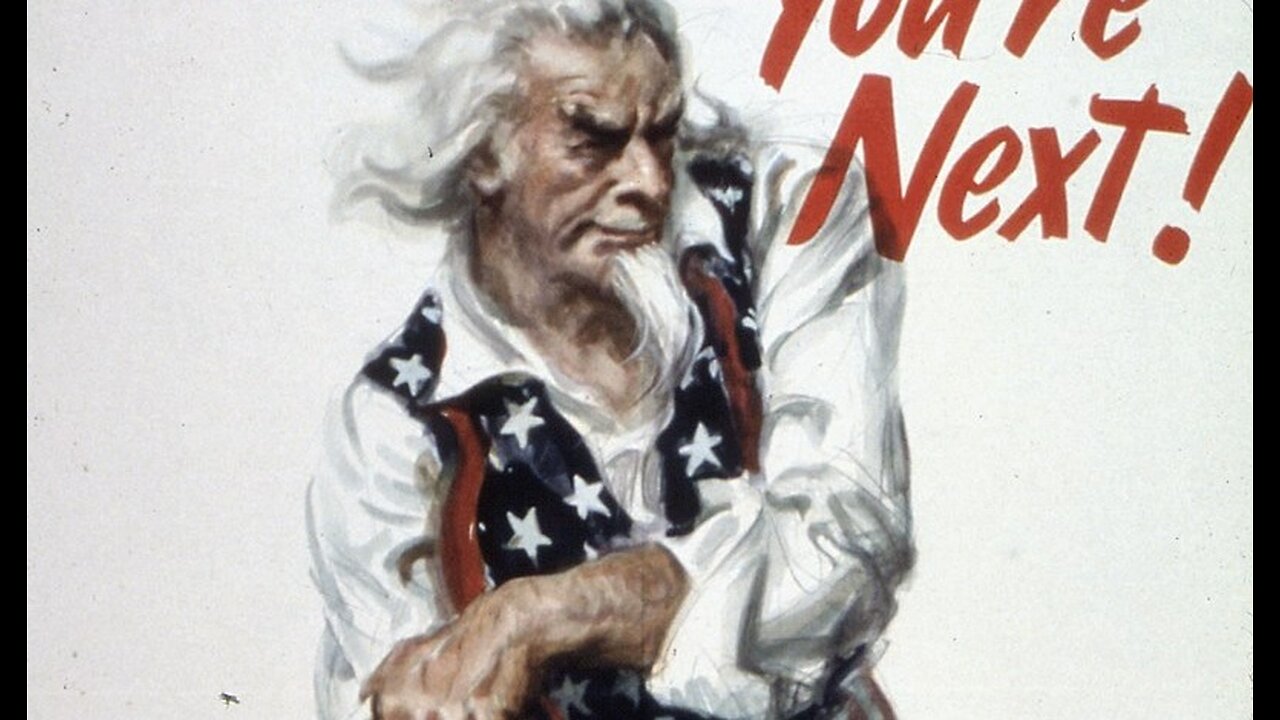
Suppressed by the U.S. Government: What People Experienced in Hiroshima and Nagasaki (1985)
Three different works that offer a powerful and poignant insight into the horrific events that occurred during the atomic bombings of Hiroshima and Nagasaki. The first of these works is a 22-minute documentary titled "Hiroshima-Nagasaki," which features actual movie footage captured in the aftermath of the bombings.
The documentary is known for its graphic and explicit nature, which is why it was suppressed by the U.S. government for many years. The documentary showcases the devastating effects of the bombs on the two cities, highlighting the immense destruction, chaos, and loss of life that followed the explosions.
The second work discussed is a collection of drawings made by children and adults who witnessed the bombings. These drawings provide a unique and emotional perspective on the horrors that were experienced by the people of Hiroshima and Nagasaki. They offer a glimpse into the traumatic experiences of those who survived the bombings and provide an intimate understanding of the aftermath of such a catastrophic event.
Finally, an animated film that is shown to school children in Hiroshima every year is also included. This film aims to educate children about the horrors of the bombings and the importance of peace. The animated film serves as a powerful reminder of the devastating consequences of nuclear war and the importance of working towards a peaceful future.
Additionally, the description includes a review of a book that discusses the attempts made by the American government to suppress the full details of what happened in Hiroshima and Nagasaki. This book sheds light on the efforts to keep the true horrors of the bombings hidden from the public and highlights the importance of remembering the events that occurred in these cities.
Overall, these three works provide a comprehensive and emotional understanding of the immense devastation caused by the atomic bombings of Hiroshima and Nagasaki, and the importance of ensuring that such catastrophic events are never repeated.
The 22 minute documentary titled "Hiroshima-Nagasaki" is a powerful and graphic account of the aftermath of the atomic bombings of Hiroshima and Nagasaki in 1945. The documentary features actual movie footage captured in the immediate aftermath of the bombings and highlights the devastating effects of the bombs on the two cities.
The documentary provides an explicit and emotional account of the chaos, destruction, and loss of life that followed the explosions. It showcases the massive scale of destruction, including the complete obliteration of buildings and structures, as well as the widespread devastation caused by the intense heat and radiation.
The documentary features interviews with survivors who recount their traumatic experiences of the bombings and provide a firsthand account of the aftermath. It also includes footage of the medical and rescue efforts that were undertaken in the wake of the bombings, highlighting the immense challenges faced by those who were tasked with treating the injured and caring for the survivors.
One of the notable aspects of this documentary is its explicit and graphic nature. The documentary was suppressed by the U.S. government for many years, as it was deemed too shocking and emotional for public consumption. However, the documentary serves as a powerful reminder of the horrific consequences of nuclear war and the importance of working towards peace.
Following the atomic bombings of Hiroshima and Nagasaki in 1945, the U.S. government took steps to suppress the full details of the realities of what had happened. One of the key ways in which they did this was by controlling the flow of information about the bombings and actively working to shape the narrative surrounding the events.
One of the key ways in which the U.S. government suppressed information about the bombings was by strictly controlling access to the affected areas. They restricted access to journalists, photographers, and other media personnel, and tightly controlled what information could be released to the public. In addition, the government imposed strict censorship on the media, preventing them from reporting on the full extent of the damage caused by the bombs.
Another way in which the U.S. government suppressed information about the bombings was through their public statements about the events. In the aftermath of the bombings, the government released statements suggesting that the bombs had been necessary to end the war quickly and save lives. They also downplayed the severity of the damage caused by the bombs and portrayed them as a relatively humane way of ending the war.
Finally, the U.S. government actively worked to suppress information about the long-term health effects of the bombings. They initially denied that radiation sickness was a significant problem, and discouraged doctors from investigating the issue. It was only in the 1950s, as the long-term health effects of the bombings became more apparent, that the government began to acknowledge the full scale of the damage caused.
On 6 and 9 August 1945, the United States detonated two atomic bombs over the Japanese cities of Hiroshima and Nagasaki, respectively. The two aerial bombings together killed between 129,000 and 226,000 people, most of whom were civilians, and remain the only use of nuclear weapons in an armed conflict. Japan surrendered to the Allies on 15 August, six days after the bombing of Nagasaki and the Soviet Union's declaration of war against Japan. The Japanese government signed the instrument of surrender on 2 September, effectively ending the war.
In the final year of World War II, the Allies prepared for a costly invasion of the Japanese mainland. This undertaking was preceded by a conventional and firebombing campaign that devastated 64 Japanese cities. The war in the European theatre concluded when Germany surrendered on 8 May 1945, and the Allies turned their full attention to the Pacific War. By July 1945, the Allies' Manhattan Project had produced two types of atomic bombs: "Fat Man", a plutonium implosion-type nuclear weapon; and "Little Boy", an enriched uranium gun-type fission weapon. The 509th Composite Group of the United States Army Air Forces was trained and equipped with the specialized Silverplate version of the Boeing B-29 Superfortress, and deployed to Tinian in the Mariana Islands. The Allies called for the unconditional surrender of the Imperial Japanese armed forces in the Potsdam Declaration on 26 July 1945, the alternative being "prompt and utter destruction". The Japanese government ignored the ultimatum.
The consent of the United Kingdom was obtained for the bombing, as was required by the Quebec Agreement, and orders were issued on 25 July by General Thomas Handy, the acting Chief of Staff of the United States Army, for atomic bombs to be used against Hiroshima, Kokura, Niigata, and Nagasaki. These targets were chosen because they were large urban areas that also held militarily significant facilities. On 6 August, a Little Boy was dropped on Hiroshima, to which Prime Minister Suzuki reiterated the Japanese government's commitment to ignore the Allies' demands and fight on. Three days later, a Fat Man was dropped on Nagasaki. Over the next two to four months, the effects of the atomic bombings killed between 90,000 and 146,000 people in Hiroshima and 60,000 and 80,000 people in Nagasaki; roughly half occurred on the first day. For months afterward, many people continued to die from the effects of burns, radiation sickness, and injuries, compounded by illness and malnutrition. Though Hiroshima had a sizable military garrison, most of the dead were civilians.
Japan surrendered to the Allies on 15 August, six days after the Soviet Union's declaration of war and the bombing of Nagasaki. The Japanese government signed the instrument of surrender on 2 September, effectively ending the war. Scholars have extensively studied the effects of the bombings on the social and political character of subsequent world history and popular culture, and there is still much debate concerning the ethical and legal justification for the bombings. Supporters claim that the atomic bombings were necessary to bring an end to the war with minimal American casualties; critics believe that the bombings were unnecessary and a war crime, and highlight the moral and ethical implications of the intentional nuclear attack on civilians.
Background
Pacific War
Main article: Pacific War
A map of East Asia and the Western Pacific during World War II
Situation of the Pacific War on 1 August 1945.
White and green: Areas still controlled by Japan included Korea, Taiwan, Indochina, and much of China, including most of the main cities, and the Dutch East Indies
Red: Allied-held areas
Grey: Neutral Soviet Union
In 1945, the Pacific War between the Empire of Japan and the Allies entered its fourth year. Most Japanese military units fought fiercely, ensuring that the Allied victory would come at an enormous cost. The 1.25 million battle casualties incurred in total by the United States in World War II included both military personnel killed in action and wounded in action. Nearly one million of the casualties occurred during the last year of the war, from June 1944 to June 1945. In December 1944, American battle casualties hit an all-time monthly high of 88,000 as a result of the German Ardennes Offensive. America's reserves of manpower were running out. Deferments for groups such as agricultural workers were tightened, and there was consideration of drafting women. At the same time, the public was becoming war-weary, and demanding that long-serving servicemen be sent home.[2]
In the Pacific, the Allies returned to the Philippines,[3] recaptured Burma,[4] and invaded Borneo.[5] Offensives were undertaken to reduce the Japanese forces remaining in Bougainville, New Guinea and the Philippines.[6] In April 1945, American forces landed on Okinawa, where heavy fighting continued until June. Along the way, the ratio of Japanese to American casualties dropped from five to one in the Philippines to two to one on Okinawa.[2] Although some Japanese soldiers were taken prisoner, most fought until they were killed or committed suicide. Nearly 99 percent of the 21,000 defenders of Iwo Jima were killed. Of the 117,000 Okinawan and Japanese troops defending Okinawa in April to June 1945, 94 percent were killed;[7] 7,401 Japanese soldiers surrendered, an unprecedentedly large number.[8]
As the Allies advanced towards Japan, conditions became steadily worse for the Japanese people. Japan's merchant fleet declined from 5,250,000 gross tons in 1941 to 1,560,000 tons in March 1945, and 557,000 tons in August 1945. Lack of raw materials forced the Japanese war economy into a steep decline after the middle of 1944. The civilian economy, which had slowly deteriorated throughout the war, reached disastrous levels by the middle of 1945. The loss of shipping also affected the fishing fleet, and the 1945 catch was only 22 percent of that in 1941. The 1945 rice harvest was the worst since 1909, and hunger and malnutrition became widespread. U.S. industrial production was overwhelmingly superior to Japan's. By 1943, the U.S. produced almost 100,000 aircraft a year, compared to Japan's production of 70,000 for the entire war. In February 1945, Prince Fumimaro Konoe advised Emperor Hirohito that defeat was inevitable, and urged him to abdicate.[9]
Preparations to invade Japan
Main article: Operation Downfall
Even before the surrender of Nazi Germany on 8 May 1945, plans were underway for the largest operation of the Pacific War, Operation Downfall, the Allied invasion of Japan.[10] The operation had two parts: Operation Olympic and Operation Coronet. Set to begin in October 1945, Olympic involved a series of landings by the U.S. Sixth Army intended to capture the southern third of the southernmost main Japanese island, Kyūshū.[11] Operation Olympic was to be followed in March 1946 by Operation Coronet, the capture of the Kantō Plain, near Tokyo on the main Japanese island of Honshū by the U.S. First, Eighth and Tenth Armies, as well as a Commonwealth Corps made up of Australian, British and Canadian divisions. The target date was chosen to allow for Olympic to complete its objectives, for troops to be redeployed from Europe, and the Japanese winter to pass.[12]
Uncle Sam holding a spanner, rolling up his sleeves
U.S. Army propaganda poster depicting Uncle Sam preparing the public for the invasion of Japan after ending war on Germany and Italy
Japan's geography made this invasion plan obvious to the Japanese; they were able to predict the Allied invasion plans accurately and thus adjust their defensive plan, Operation Ketsugō, accordingly. The Japanese planned an all-out defense of Kyūshū, with little left in reserve for any subsequent defense operations.[13] Four veteran divisions were withdrawn from the Kwantung Army in Manchuria in March 1945 to strengthen the forces in Japan,[14] and 45 new divisions were activated between February and May 1945. Most were immobile formations for coastal defense, but 16 were high quality mobile divisions.[15] In all, there were 2.3 million Japanese Army troops prepared to defend the home islands, backed by a civilian militia of 28 million men and women. Casualty predictions varied widely, but were extremely high. The Vice Chief of the Imperial Japanese Navy General Staff, Vice Admiral Takijirō Ōnishi, predicted up to 20 million Japanese deaths.[16]
On 15 June 1945, a study by the Joint War Plans Committee,[17] who provided planning information to the Joint Chiefs of Staff, estimated that Olympic would result in 130,000 to 220,000 U.S. casualties, with U.S. dead in the range from 25,000 to 46,000. Delivered on 15 June 1945, after insight gained from the Battle of Okinawa, the study noted Japan's inadequate defenses due to the very effective sea blockade and the American firebombing campaign. The Chief of Staff of the United States Army, General of the Army George Marshall, and the Army Commander in Chief in the Pacific, General of the Army Douglas MacArthur, signed documents agreeing with the Joint War Plans Committee estimate.[18]
The Americans were alarmed by the Japanese buildup, which was accurately tracked through Ultra intelligence.[19] Secretary of War Henry L. Stimson was sufficiently concerned about high American estimates of probable casualties to commission his own study by Quincy Wright and William Shockley. Wright and Shockley spoke with Colonels James McCormack and Dean Rusk, and examined casualty forecasts by Michael E. DeBakey and Gilbert Beebe. Wright and Shockley estimated the invading Allies would suffer between 1.7 and 4 million casualties in such a scenario, of whom between 400,000 and 800,000 would be dead, while Japanese fatalities would have been around 5 to 10 million.[20][21]
Marshall began contemplating the use of a weapon that was "readily available and which assuredly can decrease the cost in American lives":[22] poison gas. Quantities of phosgene, mustard gas, tear gas and cyanogen chloride were moved to Luzon from stockpiles in Australia and New Guinea in preparation for Operation Olympic, and MacArthur ensured that Chemical Warfare Service units were trained in their use.[22] Consideration was also given to using biological weapons against Japan.[23]
Air raids on Japan
Main article: Air raids on Japan
Black and white photo of a four engined World War II-era aircraft being viewed from above while it is flying over a city. A large cloud of smoke is visible immediately below the aircraft.
A B-29 over Osaka on 1 June 1945
While the United States had developed plans for an air campaign against Japan prior to the Pacific War, the capture of Allied bases in the western Pacific in the first weeks of the conflict meant that this offensive did not begin until mid-1944 when the long-ranged Boeing B-29 Superfortress became ready for use in combat.[24] Operation Matterhorn involved India-based B-29s staging through bases around Chengdu in China to make a series of raids on strategic targets in Japan.[25] This effort failed to achieve the strategic objectives that its planners had intended, largely because of logistical problems, the bomber's mechanical difficulties, the vulnerability of Chinese staging bases, and the extreme range required to reach key Japanese cities.[26]
Brigadier General Haywood S. Hansell determined that Guam, Tinian, and Saipan in the Mariana Islands would better serve as B-29 bases, but they were in Japanese hands.[27] Strategies were shifted to accommodate the air war,[28] and the islands were captured between June and August 1944. Air bases were developed,[29] and B-29 operations commenced from the Marianas in October 1944.[30] These bases were easily resupplied by cargo ships.[31] The XXI Bomber Command began missions against Japan on 18 November 1944.[32] The early attempts to bomb Japan from the Marianas proved just as ineffective as the China-based B-29s had been. Hansell continued the practice of conducting so-called high-altitude precision bombing, aimed at key industries and transportation networks, even after these tactics had not produced acceptable results.[33] These efforts proved unsuccessful due to logistical difficulties with the remote location, technical problems with the new and advanced aircraft, unfavorable weather conditions, and enemy action.[34][35]
A vast devastated area with only a few burned out buildings standing
The Operation Meetinghouse firebombing of Tokyo on the night of 9–10 March 1945, was the single deadliest air raid in history;[36] with a greater area of fire damage and loss of life than either of the atomic bombings of Hiroshima or Nagasaki.[37][38]
Hansell's successor, Major General Curtis LeMay, assumed command in January 1945 and initially continued to use the same precision bombing tactics, with equally unsatisfactory results. The attacks initially targeted key industrial facilities but much of the Japanese manufacturing process was carried out in small workshops and private homes.[39] Under pressure from United States Army Air Forces (USAAF) headquarters in Washington, LeMay changed tactics and decided that low-level incendiary raids against Japanese cities were the only way to destroy their production capabilities, shifting from precision bombing to area bombardment with incendiaries.[40] Like most strategic bombing during World War II, the aim of the air offensive against Japan was to destroy the enemy's war industries, kill or disable civilian employees of these industries, and undermine civilian morale.[41][42]
Over the next six months, the XXI Bomber Command under LeMay firebombed 64 Japanese cities.[43] The firebombing of Tokyo, codenamed Operation Meetinghouse, on 9–10 March killed an estimated 100,000 people and destroyed 41 km2 (16 sq mi) of the city and 267,000 buildings in a single night. It was the deadliest bombing raid of the war, at a cost of 20 B-29s shot down by flak and fighters.[44] By May, 75 percent of bombs dropped were incendiaries designed to burn down Japan's "paper cities". By mid-June, Japan's six largest cities had been devastated.[45] The end of the fighting on Okinawa that month provided airfields even closer to the Japanese mainland, allowing the bombing campaign to be further escalated. Aircraft flying from Allied aircraft carriers and the Ryukyu Islands also regularly struck targets in Japan during 1945 in preparation for Operation Downfall.[46] Firebombing switched to smaller cities, with populations ranging from 60,000 to 350,000. According to Yuki Tanaka, the U.S. fire-bombed over a hundred Japanese towns and cities.[47] These raids were devastating.[48]
The Japanese military was unable to stop the Allied attacks and the country's civil defense preparations proved inadequate. Japanese fighters and anti-aircraft guns had difficulty engaging bombers flying at high altitude.[49] From April 1945, the Japanese interceptors also had to face American fighter escorts based on Iwo Jima and Okinawa.[50] That month, the Imperial Japanese Army Air Service and Imperial Japanese Navy Air Service stopped attempting to intercept the air raids to preserve fighter aircraft to counter the expected invasion.[51] By mid-1945 the Japanese only occasionally scrambled aircraft to intercept individual B-29s conducting reconnaissance sorties over the country, to conserve supplies of fuel.[52] In July 1945, the Japanese had 137,800,000 litres (1,156,000 US bbl) of avgas stockpiled for the invasion of Japan. About 72,000,000 litres (604,000 US bbl) had been consumed in the home islands area in April, May and June 1945.[53] While the Japanese military decided to resume attacks on Allied bombers from late June, by this time there were too few operational fighters available for this change of tactics to hinder the Allied air raids.[54]
Atomic bomb development
Leslie Groves, Manhattan Project director, with a map of Japan
Main article: Manhattan Project
The discovery of nuclear fission by German chemists Otto Hahn and Fritz Strassmann in 1938, and its theoretical explanation by Lise Meitner and Otto Frisch, made the development of an atomic bomb a theoretical possibility.[55] Fears that a German atomic bomb project would develop atomic weapons first, especially among scientists who were refugees from Nazi Germany and other fascist countries, were expressed in the Einstein–Szilard letter in 1939. This prompted preliminary research in the United States in late 1939.[56] Progress was slow until the arrival of the British MAUD Committee report in late 1941, which indicated that only 5 to 10 kilograms of isotopically enriched uranium-235 were needed for a bomb instead of tons of natural uranium and a neutron moderator like heavy water.[57]
The 1943 Quebec Agreement merged the nuclear weapons projects of the United Kingdom and Canada, Tube Alloys and the Montreal Laboratory, with the Manhattan Project,[58][59] under the direction of Major General Leslie R. Groves, Jr., of the U.S. Army Corps of Engineers.[60] Groves appointed J. Robert Oppenheimer to organize and head the project's Los Alamos Laboratory in New Mexico, where bomb design work was carried out.[61] Two types of bombs were eventually developed, both named by Robert Serber. Little Boy was a gun-type fission weapon that used uranium-235, a rare isotope of uranium separated at the Clinton Engineer Works at Oak Ridge, Tennessee.[62] The other, known as a Fat Man device, was a more powerful and efficient, but more complicated, implosion-type nuclear weapon that used plutonium created in nuclear reactors at Hanford, Washington.[63]
There was a Japanese nuclear weapon program, but it lacked the human, mineral and financial resources of the Manhattan Project, and never made much progress towards developing an atomic bomb.[64]
Preparations
Organization and training
Three men in military fatigues, without jackets or ties.
The "Tinian Joint Chiefs": Captain William S. Parsons (left), Rear Admiral William R. Purnell (center), and Brigadier General Thomas F. Farrell (right)
The 509th Composite Group was constituted on 9 December 1944, and activated on 17 December 1944, at Wendover Army Air Field, Utah, commanded by Colonel Paul Tibbets.[65] Tibbets was assigned to organize and command a combat group to develop the means of delivering an atomic weapon against targets in Germany and Japan. Because the flying squadrons of the group consisted of both bomber and transport aircraft, the group was designated as a "composite" rather than a "bombardment" unit.[66] Due to its remoteness, Tibbets selected Wendover for his training base over Great Bend, Kansas and Mountain Home, Idaho.[67] Each bombardier completed at least 50 practice drops of inert or conventional explosive pumpkin bombs, targeting islands around Tinian and later the Japanese home islands, until as late as August 14, 1945.[68][69] Some of the missions over Japan were flown by single unescorted bombers with a single payload in order to accustom the Japanese to this pattern. They also simulated actual atomic bombing runs, including the directions of ingress and egress with respect to the wind. Tibbets himself was barred from flying most missions over Japan for fear that he might be captured and forced to reveal what he knew.[69] On 5 April 1945, the code name Operation Centerboard was assigned. The officer responsible for its allocation in the War Department's Operations Division was not cleared to know any details of it. The first bombing was later codenamed Operation Centerboard I, and the second, Operation Centerboard II.[70]
Color photo of three silver four engined World War II-era aircraft neatly lined up alongside a runway
Aircraft of the 509th Composite Group that took part in the Hiroshima bombing. Left to right: Big Stink, The Great Artiste, Enola Gay
The 509th Composite Group had an authorized strength of 225 officers and 1,542 enlisted men, almost all of whom eventually deployed to Tinian. In addition to its authorized strength, the 509th had attached to it on Tinian 51 civilian and military personnel from Project Alberta,[71] known as the 1st Technical Detachment.[72] The 509th Composite Group's 393d Bombardment Squadron was equipped with 15 Silverplate B-29s. These aircraft were specially adapted to carry nuclear weapons, and were equipped with fuel-injected engines, Curtiss Electric reversible-pitch propellers, pneumatic actuators for rapid opening and closing of bomb bay doors and other improvements.[73]
The ground support echelon of the 509th Composite Group moved by rail on 26 April 1945, to its port of embarkation at Seattle, Washington. On 6 May the support elements sailed on the SS Cape Victory for the Marianas, while group materiel was shipped on the SS Emile Berliner. The Cape Victory made brief port calls at Honolulu and Eniwetok but the passengers were not permitted to leave the dock area. An advance party of the air echelon, consisting of 29 officers and 61 enlisted men, flew by C-54 to North Field on Tinian, between 15 and 22 May.[74] There were also two representatives from Washington, D.C., Brigadier General Thomas Farrell, the deputy commander of the Manhattan Project, and Rear Admiral William R. Purnell of the Military Policy Committee,[75] who were on hand to decide higher policy matters on the spot. Along with Captain William S. Parsons, the commander of Project Alberta, they became known as the "Tinian Joint Chiefs".[76]
Choice of targets
map of Japan and the Marianas Islands indicating the routes taken by the raids. One goes straight to Iwo Jima and Hiroshima and back the same way. The other goes to the southern tip of Japan, up to Kokura, down to Nagasaki, and the southwest to Okinawa befofore heading back to Tinian.
The mission runs of 6 and 9 August, with Hiroshima, Nagasaki, and Kokura (the original target for 9 August) displayed
In April 1945, Marshall asked Groves to nominate specific targets for bombing for final approval by himself and Stimson. Groves formed a Target Committee, chaired by himself, that included Farrell, Major John A. Derry, Colonel William P. Fisher, Joyce C. Stearns and David M. Dennison from the USAAF; and scientists John von Neumann, Robert R. Wilson and William Penney from the Manhattan Project. The Target Committee met in Washington on 27 April; at Los Alamos on 10 May, where it was able to talk to the scientists and technicians there; and finally in Washington on 28 May, where it was briefed by Tibbets and Commander Frederick Ashworth from Project Alberta, and the Manhattan Project's scientific advisor, Richard C. Tolman.[77]
The Target Committee nominated five targets: Kokura (now Kitakyushu), the site of one of Japan's largest munitions plants; Hiroshima, an embarkation port and industrial center that was the site of a major military headquarters; Yokohama, an urban center for aircraft manufacture, machine tools, docks, electrical equipment and oil refineries; Niigata, a port with industrial facilities including steel and aluminum plants and an oil refinery; and Kyoto, a major industrial center. The target selection was subject to the following criteria:
The target was larger than 4.8 km (3 mi) in diameter and was an important target in a large city.
The blast wave would create effective damage.
The target was unlikely to be attacked by August 1945.[78]
These cities were largely untouched during the nightly bombing raids, and the Army Air Forces agreed to leave them off the target list so accurate assessment of the damage caused by the atomic bombs could be made. Hiroshima was described as "an important army depot and port of embarkation in the middle of an urban industrial area. It is a good radar target and it is such a size that a large part of the city could be extensively damaged. There are adjacent hills which are likely to produce a focusing effect which would considerably increase the blast damage. Due to rivers it is not a good incendiary target."[78]
The Target Committee stated that "It was agreed that psychological factors in the target selection were of great importance. Two aspects of this are (1) obtaining the greatest psychological effect against Japan and (2) making the initial use sufficiently spectacular for the importance of the weapon to be internationally recognized when publicity on it is released. ... Kyoto has the advantage of the people being more highly intelligent and hence better able to appreciate the significance of the weapon. Hiroshima has the advantage of being such a size and with possible focussing from nearby mountains that a large fraction of the city may be destroyed. The Emperor's palace in Tokyo has a greater fame than any other target but is of least strategic value."[78]
Edwin O. Reischauer, a Japan expert for the U.S. Army Intelligence Service, was incorrectly said to have prevented the bombing of Kyoto.[78] In his autobiography, Reischauer specifically refuted this claim:
... the only person deserving credit for saving Kyoto from destruction is Henry L. Stimson, the Secretary of War at the time, who had known and admired Kyoto ever since his honeymoon there several decades earlier.[79][80]
On 30 May, Stimson asked Groves to remove Kyoto from the target list due to its historical, religious and cultural significance, but Groves pointed to its military and industrial significance.[81] Stimson then approached President Harry S. Truman about the matter. Truman agreed with Stimson, and Kyoto was temporarily removed from the target list.[82] Groves attempted to restore Kyoto to the target list in July, but Stimson remained adamant.[83][84] On 25 July, Nagasaki was put on the target list in place of Kyoto. It was a major military port, one of Japan's largest shipbuilding and repair centers, and an important producer of naval ordnance.[84]
Proposed demonstration
In early May 1945, the Interim Committee was created by Stimson at the urging of leaders of the Manhattan Project and with the approval of Truman to advise on matters pertaining to nuclear technology.[85] They agreed that the atomic bomb was to be used (1) against Japan at the earliest opportunity, (2) without special warning, and (3) on a "dual target" of military installation surrounded by other buildings susceptible to damage.[86]
During the meetings on 31 May and 1 June, scientist Ernest Lawrence had suggested giving the Japanese a non-combat demonstration.[87] Arthur Compton later recalled that:
It was evident that everyone would suspect trickery. If a bomb were exploded in Japan with previous notice, the Japanese air power was still adequate to give serious interference. An atomic bomb was an intricate device, still in the developmental stage. Its operation would be far from routine. If during the final adjustments of the bomb the Japanese defenders should attack, a faulty move might easily result in some kind of failure. Such an end to an advertised demonstration of power would be much worse than if the attempt had not been made. It was now evident that when the time came for the bombs to be used we should have only one of them available, followed afterwards by others at all-too-long intervals. We could not afford the chance that one of them might be a dud. If the test were made on some neutral territory, it was hard to believe that Japan's determined and fanatical military men would be impressed. If such an open test were made first and failed to bring surrender, the chance would be gone to give the shock of surprise that proved so effective. On the contrary, it would make the Japanese ready to interfere with an atomic attack if they could. Though the possibility of a demonstration that would not destroy human lives was attractive, no one could suggest a way in which it could be made so convincing that it would be likely to stop the war.[88]
The possibility of a demonstration was raised again in the Franck Report issued by physicist James Franck on 11 June and the Scientific Advisory Panel rejected his report on 16 June, saying that "we can propose no technical demonstration likely to bring an end to the war; we see no acceptable alternative to direct military use." Franck then took the report to Washington, D.C., where the Interim Committee met on 21 June to re-examine its earlier conclusions; but it reaffirmed that there was no alternative to the use of the bomb on a military target.[89]
Like Compton, many U.S. officials and scientists argued that a demonstration would sacrifice the shock value of the atomic attack, and the Japanese could deny the atomic bomb was lethal, making the mission less likely to produce surrender. Allied prisoners of war might be moved to the demonstration site and be killed by the bomb. They also worried that the bomb might be a failure, as the Trinity test was that of a stationary device, not an air-dropped bomb. In addition, although more bombs were in production, only two would be available at the start of August, and they cost billions of dollars, so using one for a demonstration would be expensive.[90][91]
Leaflets
Leaflet showing B-29s dropping bombs. There are 12 circles with 12 Japanese cities named in Japanese writing.
Various leaflets were dropped on Japan, three versions showing the names of 11 or 12 Japanese cities targeted for destruction by firebombing. The other side contained text stating "... we cannot promise that only these cities will be among those attacked ..."[92]
For several months, the U.S. had warned civilians of potential air raids by dropping more than 63 million leaflets across Japan. Many Japanese cities suffered terrible damage from aerial bombings; some were as much as 97 percent destroyed. LeMay thought that leaflets would increase the psychological impact of bombing, and reduce the international stigma of area-bombing cities. Even with the warnings, Japanese opposition to the war remained ineffective. In general, the Japanese regarded the leaflet messages as truthful, with many Japanese choosing to leave major cities. The leaflets caused such concern that the government ordered the arrest of anyone caught in possession of a leaflet.[92][93] Leaflet texts were prepared by recent Japanese prisoners of war because they were thought to be the best choice "to appeal to their compatriots".[94]
In preparation for dropping an atomic bomb on Hiroshima, the Oppenheimer-led Scientific Panel of the Interim Committee decided against a demonstration bomb and against a special leaflet warning. Those decisions were implemented because of the uncertainty of a successful detonation and also because of the wish to maximize shock in the leadership.[95] No warning was given to Hiroshima that a new and much more destructive bomb was going to be dropped.[96] Various sources gave conflicting information about when the last leaflets were dropped on Hiroshima prior to the atomic bomb. Robert Jay Lifton wrote that it was 27 July,[96] and Theodore H. McNelly wrote that it was 30 July.[95] The USAAF history noted that eleven cities were targeted with leaflets on 27 July, but Hiroshima was not one of them, and there were no leaflet sorties on 30 July.[93] Leaflet sorties were undertaken on 1 and 4 August. Hiroshima may have been leafleted in late July or early August, as survivor accounts talk about a delivery of leaflets a few days before the atomic bomb was dropped.[96] Three versions were printed of a leaflet listing 11 or 12 cities targeted for firebombing; a total of 33 cities listed. With the text of this leaflet reading in Japanese "... we cannot promise that only these cities will be among those attacked ..."[92] Hiroshima was not listed.[97][98]
Consultation with Britain and Canada
General Thomas Handy's order to General Carl Spaatz ordering the dropping of the atomic bombs
In 1943, the United States and the United Kingdom signed the Quebec Agreement, which stipulated that nuclear weapons would not be used against another country without mutual consent. Stimson therefore had to obtain British permission. A meeting of the Combined Policy Committee, which included one Canadian representative, was held at the Pentagon on 4 July 1945.[99] Field Marshal Sir Henry Maitland Wilson announced that the British government concurred with the use of nuclear weapons against Japan, which would be officially recorded as a decision of the Combined Policy Committee.[99][100][101] As the release of information to third parties was also controlled by the Quebec Agreement, discussion then turned to what scientific details would be revealed in the press announcement of the bombing. The meeting also considered what Truman could reveal to Joseph Stalin, the leader of the Soviet Union, at the upcoming Potsdam Conference, as this also required British concurrence.[99]
Orders for the attack were issued to General Carl Spaatz on 25 July under the signature of General Thomas T. Handy, the acting chief of staff, since Marshall was at the Potsdam Conference with Truman.[102] It read:
The 509th Composite Group, 20th Air Force will deliver its first special bomb as soon as weather will permit visual bombing after about 3 August 1945 on one of the targets: Hiroshima, Kokura, Niigata and Nagasaki. To carry military and civilian scientific personnel from the War Department to observe and record the effects of the explosion of the bomb, additional aircraft will accompany the airplane carrying the bomb. The observing planes will stay several miles distant from the point of impact of the bomb.
Additional bombs will be delivered on the above targets as soon as made ready by the project staff. Further instructions will be issued concerning targets other than those listed above.[103]
That day, Truman noted in his diary that:
This weapon is to be used against Japan between now and August 10th. I have told the Sec. of War, Mr. Stimson, to use it so that military objectives and soldiers and sailors are the target and not women and children. Even if the Japs are savages, ruthless, merciless and fanatic, we as the leader of the world for the common welfare cannot drop that terrible bomb on the old capital [Kyoto] or the new [Tokyo]. He and I are in accord. The target will be a purely military one.[104]
Potsdam Declaration
Main article: Potsdam Declaration
The 16 July success of the Trinity Test in the New Mexico desert exceeded expectations.[105] On 26 July, Allied leaders issued the Potsdam Declaration, which outlined the terms of surrender for Japan. The declaration was presented as an ultimatum and stated that without a surrender, the Allies would attack Japan, resulting in "the inevitable and complete destruction of the Japanese armed forces and just as inevitably the utter devastation of the Japanese homeland". The atomic bomb was not mentioned in the communiqué.[106]
On 28 July, Japanese papers reported that the declaration had been rejected by the Japanese government. That afternoon, Prime Minister Kantarō Suzuki declared at a press conference that the Potsdam Declaration was no more than a rehash (yakinaoshi) of the Cairo Declaration, that the government intended to ignore it (mokusatsu, "kill by silence"), and that Japan would fight to the end.[107] The statement was taken by both Japanese and foreign papers as a clear rejection of the declaration. Emperor Hirohito, who was waiting for a Soviet reply to non-committal Japanese peace feelers, made no move to change the government position.[108] Japan's willingness to surrender remained conditional on the preservation of the kokutai (Imperial institution and national polity), assumption by the Imperial Headquarters of responsibility for disarmament and demobilization, no occupation of the Japanese Home Islands, Korea or Formosa, and delegation of the punishment of war criminals to the Japanese government.[109]
At Potsdam, Truman agreed to a request from Winston Churchill that Britain be represented when the atomic bomb was dropped. William Penney and Group Captain Leonard Cheshire were sent to Tinian, but found that LeMay would not let them accompany the mission. All they could do was send a strongly worded signal to Wilson.[110]
Bombs
The Little Boy bomb, except for the uranium payload, was ready at the beginning of May 1945.[111] There were two uranium-235 components, a hollow cylindrical projectile and a cylindrical target insert. The projectile was completed on 15 June, and the target insert on 24 July.[112] The projectile and eight bomb pre-assemblies (partly assembled bombs without the powder charge and fissile components) left Hunters Point Naval Shipyard, California, on 16 July aboard the cruiser USS Indianapolis, and arrived on Tinian on 26 July.[113] The target insert followed by air on 30 July, accompanied by Commander Francis Birch from Project Alberta.[112] Responding to concerns expressed by the 509th Composite Group about the possibility of a B-29 crashing on takeoff, Birch had modified the Little Boy design to incorporate a removable breech plug that would permit the bomb to be armed in flight.[111]
The first plutonium core, along with its polonium-beryllium urchin initiator, was transported in the custody of Project Alberta courier Raemer Schreiber in a magnesium field carrying case designed for the purpose by Philip Morrison. Magnesium was chosen because it does not act as a neutron reflector.[114] The core departed from Kirtland Army Air Field on a C-54 transport aircraft of the 509th Composite Group's 320th Troop Carrier Squadron on 26 July, and arrived at North Field 28 July. Three Fat Man high-explosive pre-assemblies, designated F31, F32, and F33, were picked up at Kirtland on 28 July by three B-29s, two from the 393d Bombardment Squadron plus one from the 216th Army Air Force Base Unit, and transported to North Field, arriving on 2 August.[115]
Hiroshima
Hiroshima during World War II
A Silver aircraft with "Enola Gay" and "82" painted on the nose. Seven men stand in front of it. Four are wearing shorts, four are wearing T-shirts, and the only ones with hats have baseball caps. Tibbets is distinctively wearing correct uniform.
The Enola Gay dropped the "Little Boy" atomic bomb on Hiroshima. Paul Tibbets (center in photograph) can be seen with six members of the ground crew.
At the time of its bombing, Hiroshima was a city of industrial and military significance. A number of military units were located nearby, the most important of which was the headquarters of Field Marshal Shunroku Hata's Second General Army, which commanded the defense of all of southern Japan,[116] and was located in Hiroshima Castle. Hata's command consisted of some 400,000 men, most of whom were on Kyushu where an Allied invasion was correctly anticipated.[117] Also present in Hiroshima were the headquarters of the 59th Army, the 5th Division and the 224th Division, a recently formed mobile unit.[118] The city was defended by five batteries of 70 mm and 80 mm (2.8 and 3.1 inch) anti-aircraft guns of the 3rd Anti-Aircraft Division, including units from the 121st and 122nd Anti-Aircraft Regiments and the 22nd and 45th Separate Anti-Aircraft Battalions. In total, an estimated 40,000 Japanese military personnel were stationed in the city.[119]
Hiroshima was a supply and logistics base for the Japanese military.[120] The city was a communications center, a key port for shipping, and an assembly area for troops.[81] It supported a large war industry, manufacturing parts for planes and boats, for bombs, rifles, and handguns.[121] The center of the city contained several reinforced concrete buildings and lighter structures. Outside the center, the area was congested by a dense collection of small timber workshops set among Japanese houses. A few larger industrial plants lay near the outskirts of the city. The houses were constructed of timber with tile roofs, and many of the industrial buildings were also built around timber frames. The city as a whole was highly susceptible to fire damage.[122] It was the second largest city in Japan after Kyoto that was still undamaged by air raids,[123] primarily because it lacked the aircraft manufacturing industry that was the XXI Bomber Command's priority target. On 3 July, the Joint Chiefs of Staff placed it off limits to bombers, along with Kokura, Niigata and Kyoto.[124]
The population of Hiroshima had reached a peak of over 381,000 earlier in the war but prior to the atomic bombing, the population had steadily decreased because of a systematic evacuation ordered by the Japanese government. At the time of the attack, the population was approximately 340,000–350,000.[125] Residents wondered why Hiroshima had been spared destruction by firebombing.[126] Some speculated that the city was to be saved for U.S. occupation headquarters, others thought perhaps their relatives in Hawaii and California had petitioned the U.S. government to avoid bombing Hiroshima.[127] More realistic city officials had ordered buildings torn down to create long, straight firebreaks.[128] These continued to be expanded and extended up to the morning of 6 August 1945.[129]
Bombing of Hiroshima
Hiroshima was the primary target of the first atomic bombing mission on 6 August, with Kokura and Nagasaki as alternative targets. The 393d Bombardment Squadron B-29 Enola Gay, named after Tibbets's mother and piloted by Tibbets, took off from North Field, Tinian, about six hours' flight time from Japan.[130] Enola Gay was accompanied by two other B-29s: The Great Artiste, commanded by Major Charles Sweeney, which carried instrumentation, and a then-nameless aircraft later called Necessary Evil, commanded by Captain George Marquardt. Necessary Evil was the photography aircraft.[131]
A typed page of instructions
Strike order for the Hiroshima bombing as posted on 5 August 1945
Special Mission 13, primary target Hiroshima, 6 August 1945[131][132] Aircraft Pilot Call sign Mission role
Straight Flush Major Claude R. Eatherly Dimples 85 Weather reconnaissance (Hiroshima)
Jabit III Major John A. Wilson Dimples 71 Weather reconnaissance (Kokura)
Full House Major Ralph R. Taylor Dimples 83 Weather reconnaissance (Nagasaki)
Enola Gay Colonel Paul W. Tibbets Dimples 82 Weapon delivery
The Great Artiste Major Charles W. Sweeney Dimples 89 Blast measurement instrumentation
Necessary Evil Captain George W. Marquardt Dimples 91 Strike observation and photography
Top Secret Captain Charles F. McKnight Dimples 72 Strike spare – did not complete mission
After leaving Tinian, the aircraft made their way separately to Iwo Jima to rendezvous with Sweeney and Marquardt at 05:55 at 2,800 meters (9,200 ft),[133] and set course for Japan. The aircraft arrived over the target in clear visibility at 9,470 meters (31,060 ft).[134] Parsons, who was in command of the mission, armed the bomb in flight to minimize the risks during takeoff. He had witnessed four B-29s crash and burn at takeoff, and feared that a nuclear explosion would occur if a B-29 crashed with an armed Little Boy on board.[135] His assistant, Second Lieutenant Morris R. Jeppson, removed the safety devices 30 minutes before reaching the target area.[136]
Another view of the mushroom cloud forming, from further away.
The Hiroshima atom bomb cloud 2–5 minutes after detonation[137]
During the night of 5–6 August, Japanese early warning radar detected the approach of numerous American aircraft headed for the southern part of Japan. Radar detected 65 bombers headed for Saga, 102 bound for Maebashi, 261 en route to Nishinomiya, 111 headed for Ube and 66 bound for Imabari. An alert was given and radio broadcasting stopped in many cities, among them Hiroshima. The all-clear was sounded in Hiroshima at 00:05.[138] About an hour before the bombing, the air raid alert was sounded again, as Straight Flush flew over the city. It broadcast a short message which was picked up by Enola Gay. It read: "Cloud cover less than 3/10th at all altitudes. Advice: bomb primary."[139] The all-clear was sounded over Hiroshima again at 07:09.[140]
At 08:09, Tibbets started his bomb run and handed control over to his bombardier, Major Thomas Ferebee.[141] The release at 08:15 (Hiroshima time) went as planned, and the Little Boy containing about 64 kg (141 lb) of uranium-235 took 44.4 seconds to fall from the aircraft flying at about 9,400 meters (31,000 ft) to a detonation height of about 580 meters (1,900 ft) above the city.[142][143] Enola Gay traveled 18.5 km (11.5 mi) before it felt the shock waves from the blast.[144]
Due to crosswind, the bomb missed the aiming point, the Aioi Bridge, by approximately 240 m (800 ft) and detonated directly over Shima Surgical Clinic.[145] It released the equivalent energy of 16 ± 2 kilotons of TNT (66.9 ± 8.4 TJ).[142] The weapon was considered very inefficient, with only 1.7 percent of its material fissioning.[146] The radius of total destruction was about 1.6 kilometres (1 mi), with resulting fires across 11 km2 (4.4 sq mi).[147]
Enola Gay stayed over the target area for two minutes and was 16 kilometres (10 mi) away when the bomb detonated. Only Tibbets, Parsons, and Ferebee knew of the nature of the weapon; the others on the bomber were only told to expect a blinding flash and given black goggles. "It was hard to believe what we saw", Tibbets told reporters, while Parsons said "the whole thing was tremendous and awe-inspiring ... the men aboard with me gasped 'My God'." He and Tibbets compared the shockwave to "a close burst of ack-ack fire".[148]
Events on the ground
People on the ground reported a pika (ピカ)—a brilliant flash of light—followed by a don (ドン)—a loud booming sound.[149] Some 70,000–80,000 people, around 30 percent of the population of Hiroshima at the time, were killed by the blast and resultant firestorm,[150][151] and another 70,000 were injured.[152] It is estimated that as many as 20,000 Japanese military personnel were killed.[153] U.S. surveys estimated that 12 km2 (4.7 sq mi) of the city were destroyed. Japanese officials determined that 69 percent of Hiroshima's buildings were destroyed and another 6 to 7 percent damaged.[154]
Some of the reinforced concrete buildings in Hiroshima had been very strongly constructed because of the earthquake danger in Japan, and their framework did not collapse even though they were fairly close to the blast center. Since the bomb detonated in the air, the blast was directed more downward than sideways, which was largely responsible for the survival of the Prefectural Industrial Promotional Hall, now commonly known as the Genbaku (A-bomb) dome, which was only 150 m (490 ft) from ground zero (the hypocenter). The ruin was named Hiroshima Peace Memorial and was made a UNESCO World Heritage Site in 1996 over the objections of the United States and China, which expressed reservations on the grounds that other Asian nations were the ones who suffered the greatest loss of life and property, and a focus on Japan lacked historical perspective.[155] The bombing started intense fires that spread rapidly through timber and paper homes, burning everything in a radius of 2 kilometers (1.2 mi).[156] As in other Japanese cities, the firebreaks proved ineffective.[157]
Hiroshima bombing
A devastated area very similar to the one of Tokyo above
Hiroshima in the aftermath of the bombing
Ruins of Hiroshima
Ruins of Hiroshima
The Hiroshima Genbaku Dome after the bombing
The Hiroshima Genbaku Dome after the bombing
A burned out domed building surrounded by rubble
The pattern of the kimono worn by a survivor burned into their skin in tight-fitting areas.
A woman's back, with chequered-shaped burns
Direct, thermal flash burns
22-year old victim Toyoko Kugata being treated at the Hiroshima Red Cross Hospital (6 October 1945)
22-year old victim Toyoko Kugata being treated at the Hiroshima Red Cross Hospital (6 October 1945)
A photograph of the aftermath of the bombing of Hiroshima
A photograph of the aftermath of the bombing of Hiroshima
Memorial at Andersonville NHS for the American airmen who died in the blast.
Memorial at Andersonville NHS for the American airmen who died in the blast.
A victim with burns
A victim with burns
A victim with whole body burns
A victim with whole body burns
A victim with whole body burns
A victim with whole body burns
Victim with burns on her back
Victim with burns on her back
Corpse near the Western Parade Ground
Corpse near the Western Parade Ground
A mobilized school girl suffered burns to face
A mobilized school girl suffered burns to face
Elder sister and younger brother who suffered radiation disease. The brother died in 1949 and the sister in 1965.
Elder sister and younger brother who suffered radiation disease. The brother died in 1949 and the sister in 1965.
The air raid warning had been cleared at 07:31, and many people were outside, going about their activities.[158] Eizō Nomura was the closest known survivor, being in the basement of a reinforced concrete building (it remained as the Rest House after the war) only 170 meters (560 ft) from ground zero at the time of the attack.[159][160] He died in 1982, aged 84.[161] Akiko Takakura was among the closest survivors to the hypocenter of the blast. She was in the solidly-built Bank of Hiroshima only 300 meters (980 ft) from ground-zero at the time of the attack.[162]
For decades this "Hiroshima strike" photo was misidentified as the mushroom cloud of the bomb that formed at c. 08:16.[163][164] However, due to its much greater height, the scene was identified by a researcher in March 2016 as the firestorm-cloud that engulfed the city,[164] a fire that reached its peak intensity some three hours after the bomb.[165]
Over 90 percent of the doctors and 93 percent of the nurses in Hiroshima were killed or injured—most had been in the downtown area which received the greatest damage.[166] The hospitals were destroyed or heavily damaged. Only one doctor, Terufumi Sasaki, remained on duty at the Red Cross Hospital.[157] Nonetheless, by early afternoon the police and volunteers had established evacuation centres at hospitals, schools and tram stations, and a morgue was established in the Asano library.[167] Survivors of the blast gathered for medical treatment, but many would die before receiving any help, leaving behind rings of corpses around hospitals.[168]
Most elements of the Japanese Second General Army headquarters were undergoing physical training on the grounds of Hiroshima Castle, barely 820 metres (900 yd) from the hypocenter. The attack killed 3,243 troops on the parade ground.[169] The communications room of Chugoku Military District Headquarters that was responsible for issuing and lifting air raid warnings was located in a semi-basement in the castle. Yoshie Oka, a Hijiyama Girls High School student who had been mobilized to serve as a communications officer, had just sent a message that the alarm had been issued for Hiroshima and neighboring Yamaguchi, when the bomb exploded. She used a special phone to inform Fukuyama Headquarters (some 100 kilometers (62 mi) away) that "Hiroshima has been attacked by a new type of bomb. The city is in a state of near-total destruction."[170]
Since Mayor Senkichi Awaya had been killed while eating breakfast with his son and granddaughter at the mayoral residence, Field Marshal Shunroku Hata, who was only slightly wounded, took over the administration of the city, and coordinated relief efforts. Many of his staff had been killed or fatally wounded, including Lieutenant Colonel Yi U, a prince of the Korean imperial family who was serving as a General Staff Officer.[171][172] Hata's senior surviving staff officer was the wounded Colonel Kumao Imoto, who acted as his chief of staff. Soldiers from the undamaged Hiroshima Ujina Harbor used Shin'yō-class suicide motorboats, intended to repel the American invasion, to collect the wounded and take them down the rivers to the military hospital at Ujina.[171] Trucks and trains brought in relief supplies and evacuated survivors from the city.[173]
Twelve American airmen were imprisoned at the Chugoku Military Police Headquarters, about 400 metres (1,300 ft) from the hypocenter of the blast.[174] Most died instantly, although two were reported to have been executed by their captors, and two prisoners badly injured by the bombing were left next to the Aioi Bridge by the Kempei Tai, where they were stoned to death.[175][176] Eight U.S. prisoners of war killed as part of the medical experiments program at Kyushu University were falsely reported by Japanese authorities as having been killed in the atomic blast as part of an attempted cover up.[177]
Japanese realization of the bombing
Hiroshima before the bombing
Hiroshima after the bombing and subsequent firestorm
The Tokyo control operator of the Japan Broadcasting Corporation noticed that the Hiroshima station had gone off the air. He tried to re-establish his program by using another telephone line, but it too had failed.[178] About 20 minutes later the Tokyo railroad telegraph center realized that the main line telegraph had stopped working just north of Hiroshima. From some small railway stops within 16 km (10 mi) of the city came unofficial and confused reports of a terrible explosion in Hiroshima. All these reports were transmitted to the headquarters of the Imperial Japanese Army General Staff.[179]
Military bases repeatedly tried to call the Army Control Station in Hiroshima. The complete silence from that city puzzled the General Staff; they knew that no large enemy raid had occurred and that no sizable store of explosives was in Hiroshima at that time. A young officer was instructed to fly immediately to Hiroshima, to land, survey the damage, and return to Tokyo with reliable information for the staff. It was felt that nothing serious had taken place and that the explosion was just a rumor.[179]
The staff officer went to the airport and took off for the southwest. After flying for about three hours, while still nearly 160 km (100 mi) from Hiroshima, he and his pilot saw a great cloud of smoke from the firestorm created by the bomb. After circling the city to survey the damage they landed south of the city, where the staff officer, after reporting to Tokyo, began to organize relief measures. Tokyo's first indication that the city had been destroyed by a new type of bomb came from President Truman's announcement of the strike, sixteen hours later.[179]
Events of 7–9 August
See also: Mokusatsu
Truman talks about the bombing of Hiroshima
0:26
President Truman talks about the bombing of Hiroshima, which he describes as "a military base", after his return from the Potsdam Conference.
Problems playing this file? See media help.
After the Hiroshima bombing, Truman issued a statement announcing the use of the new weapon. He stated, "We may be grateful to Providence" that the German atomic bomb project had failed, and that the United States and its allies had "spent two billion dollars on the greatest scientific gamble in history—and won". Truman then warned Japan: "If they do not now accept our terms, they may expect a rain of ruin from the air, the like of which has never been seen on this earth. Behind this air attack will follow sea and land forces in such numbers and power as they have not yet seen and with the fighting skill of which they are already well aware."[180] This was a widely broadcast speech picked up by Japanese news agencies.[181]
Brownish leaflet covered in Japanese writing
Leaflet AB12, with information on the Hiroshima bomb and a warning to civilians to petition the Emperor to surrender was dropped over Japan beginning on 9 August, by the 509th Composite Group.[182] An AB11 is in the possession of the Nagasaki Atomic Bomb Museum.[183]
The 50,000-watt standard wave station on Saipan, the OWI radio station, broadcast a similar message to Japan every 15 minutes about Hiroshima, stating that more Japanese cities would face a similar fate in the absence of immediate acceptance of the terms of the Potsdam Declaration and emphatically urged civilians to evacuate major cities. Radio Japan, which continued to extoll victory for Japan by never surrendering,[92] had informed the Japanese of the destruction of Hiroshima by a single bomb.[184] Prime Minister Suzuki felt compelled to meet the Japanese press, to whom he reiterated his government's commitment to ignore the Allies' demands and fight on.[185]
Soviet Foreign Minister Vyacheslav Molotov had informed Tokyo of the Soviet Union's unilateral abrogation of the Soviet–Japanese Neutrality Pact on 5 April.[186] At two minutes past midnight on 9 August, Tokyo time, Soviet infantry, armor, and air forces had launched the Manchurian Strategic Offensive Operation.[187] Four hours later, word reached Tokyo of the Soviet Union's official declaration of war. The senior leadership of the Japanese Army began preparations to impose martial law on the nation, with the support of Minister of War Korechika Anami, to stop anyone attempting to make peace.[188]
On 7 August, a day after Hiroshima was destroyed, Dr. Yoshio Nishina and other atomic physicists arrived at the city, and carefully examined the damage. They then went back to Tokyo and told the cabinet that Hiroshima was indeed destroyed by a nuclear weapon. Admiral Soemu Toyoda, the Chief of the Naval General Staff, estimated that no more than one or two additional bombs could be readied, so they decided to endure the remaining attacks, acknowledging "there would be more destruction but the war would go on".[189] American Magic codebreakers intercepted the cabinet's messages.[190]
Purnell, Parsons, Tibbets, Spaatz, and LeMay met on Guam that same day to discuss what should be done next.[191] Since there was no indication of Japan surrendering,[190] they decided to proceed with dropping another bomb. Parsons said that Project Alberta would have it ready by 11 August, but Tibbets pointed to weather reports indicating poor flying conditions on that day due to a storm, and asked if the bomb could be readied by 9 August. Parsons agreed to try to do so.[192][191]
Nagasaki
Nagasaki during World War II
Formal picture of ten men in uniform. The five standing are wearing ties, and all but one of the ten wears a peaked cap or garrison cap.
The Bockscar and its crew, who dropped a Fat Man atomic bomb on Nagasaki
The city of Nagasaki had been one of the largest seaports in southern Japan, and was of great wartime importance because of its wide-ranging industrial activity, including the production of ordnance, ships, military equipment, and other war materials. The four largest companies in the city were Mitsubishi Shipyards, Electrical Shipyards, Arms Plant, and Steel and Arms Works, which employed about 90 percent of the city's labor force, and accounted for 90 percent of the city's industry.[193] Although an important industrial city, Nagasaki had been spared from firebombing because its geography made it difficult to locate at night with AN/APQ-13 radar.[124]
Unlike the other target cities, Nagasaki had not been placed off limits to bombers by the Joint Chiefs of Staff's 3 July directive,[124][194] and was bombed on a small scale five times. During one of these raids on 1 August, a number of conventional high-explosive bombs were dropped on the city. A few hit the shipyards and dock areas in the southwest portion of the city, and several hit the Mitsubishi Steel and Arms Works.[193] By early August, the
-
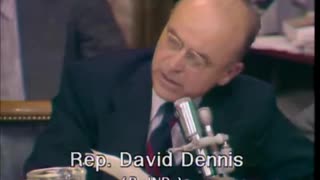 9:22:13
9:22:13
The Memory Hole
19 days agoNixon Impeachment Hearings Day 4 (1974-07-26)
440 -
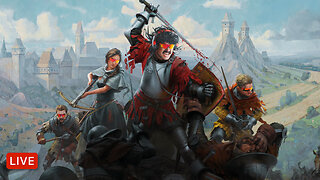 LIVE
LIVE
Dr Disrespect
2 hours ago🔴LIVE - DR DISRESPECT - KINGDOM COME: DELIVERANCE 2 - FIRST IMPRESSION
4,006 watching -
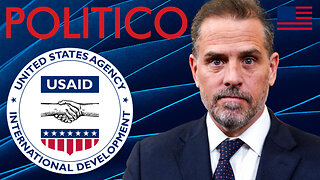 LIVE
LIVE
The Charlie Kirk Show
1 hour agoGaza Thoughts + DOGE The Destroyer | Sen. Schmitt, Benz | 2.5.2025
10,309 watching -
 LIVE
LIVE
Simply Bitcoin
2 hours ago $0.37 earnedNEW REPORT: Bitcoin ETF Insider Doubles Down on UNTHINKABLE 2030 prediction! | EP 1176
309 watching -
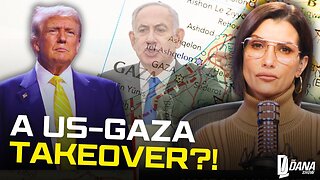 LIVE
LIVE
The Dana Show with Dana Loesch
1 hour agoTRUMP PLANS TO TAKE OVER GAZA | The Dana Show LIVE On Rumble!
664 watching -
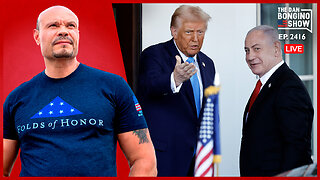 59:36
59:36
The Dan Bongino Show
4 hours agoTrump Shocks The World With Major Announcement (Ep. 2416) - 02/05/2025
624K931 -
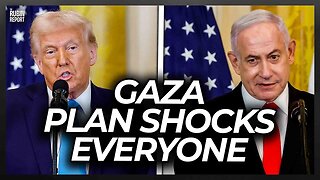 1:19:04
1:19:04
The Rubin Report
3 hours agoTrump & Netanyahu Shock with Truly Unexpected Plan for Gaza
63.5K61 -
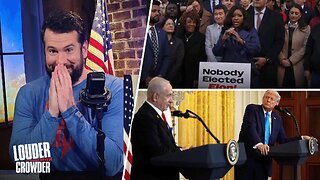 1:59:23
1:59:23
Steven Crowder
5 hours ago🔴 Trump's Hitlist Grows: USAID, Dept. of Education, CIA, and... Gaza?
385K325 -
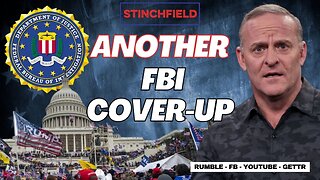 57:49
57:49
Grant Stinchfield
2 hours ago $1.53 earnedThe FBI Withholds 5000 Names of Agents & Employees Who Hunted Down J6'ers
9.05K4 -
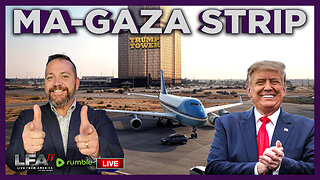 2:02:40
2:02:40
LFA TV
17 hours agoMA-GAZA STRIP! | LIVE FROM AMERICA 2.5.25 11am
55.1K13